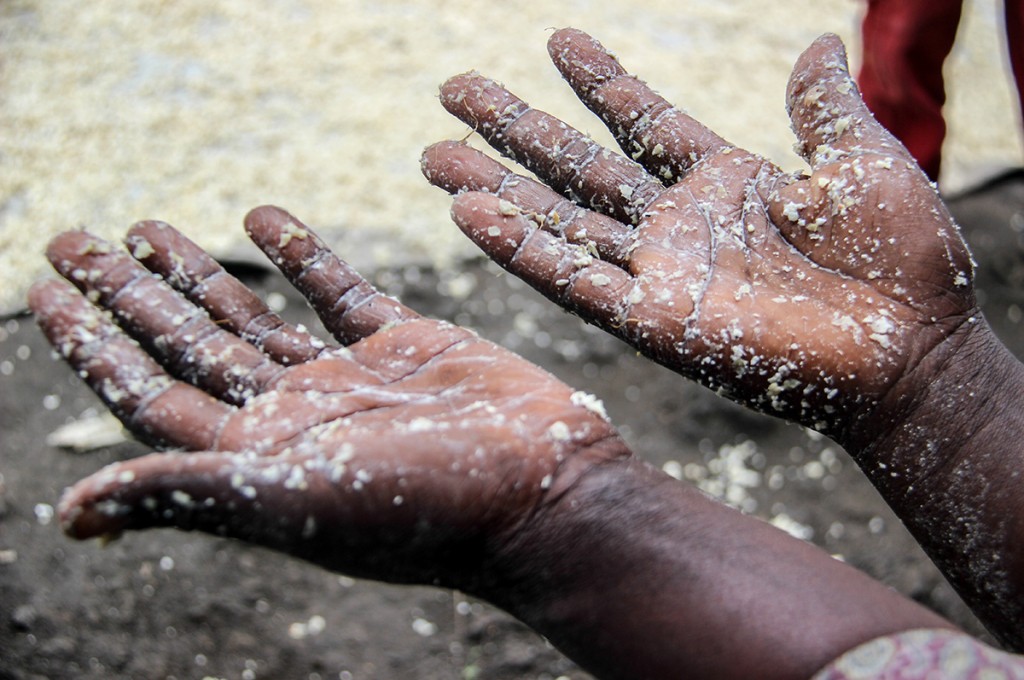
Esther Nsapu, GPJ Democratic Republic of Congo
Furaha Tity, a business owner and mother of five in Kitchanga, DRC, spreads fermented corn kernels across a tarp. The kernels are one of the main ingredients in her craft brew, mandale.
KITCHANGA, DEMOCRATIC REPUBLIC OF CONGO — In Kitchanga, a rural town in eastern DRC’s North Kivu province, when a green or blue-and-white-striped plastic bag is seen flying on a stick, it’s a sign that there’s something special for sale. Mandale, one of the most sought-after local brews, that is.
Mandale, also known as “the stomach remedy,” is a famous style of beer brewed primarily by women. For the women of Kitchanga, it’s a bold entrepreneurial move to build a small artisanal brewing facility in the town, but the beer is popular, and the business enables them to provide for their families single-handedly.
Furaha Tity, a mother of five and the wife of a farmer, is one such mandale entrepreneur. Tity began to brew the locally cherished craft beer in 2011 while in Mweso, a village approximately 20 kilometers (12 miles) north, before relocating to Kitchanga.



Today, Tity rents a small house where customers meet to relish the distinct flavors of her unique product. In addition to friends and neighbors who sometimes pass by to say hello and taste her brew, nearly 20 people visit the house per day.
Tity, 31, believes that a good drink is another wellspring from which people draw wisdom.
“I call upon my fellow villagers to always consume our local drink, which is the women’s own making. This way they can not only promote us, as women, but also value women’s work,” she says.
Mwisha Mixona, one of Tity’s customers, believes that the mandale has no equal among many local beer brands. The mandale is rich in several vitamins and proteins, he says.
Tity says, “The smallest serving of mandale costs as little as 200 Congolese francs [14 cents].”
While mandale is loved thanks to its low prices, it’s inspired many women across Kitchanga and elsewhere to turn their passion for making it into successful businesses.
Most consumers, however, are men, since women rarely enjoy this style of beer.
Many say mandale is an “all-in-one drink,” as it fuels the feeling of satiety and keeps you from needing to eat another meal. The majority of mandale lovers are those who engage in physically demanding activities that often require explosive bursts of energy or unfailing strength throughout the day. These drinkers include porters and people who toil on stone-crushing sites.
During a recent visit to her house, Tity volunteered to share her secret recipe with Global Press readers.
What you need
2 empty bags, for storing the corn
A pestle and mortar
Access to a flour mill or a food processor
A sunny space where your corn kernels can dry for three days
Ingredients
100 kilograms (220 pounds) of corn
80 liters (21 gallons) of water
1 kilogram (about 2 pounds) of sorghum
1 kilogram (about 2 pounds) of millet
Makes 40 liters (10.5 gallons)
Furaha Tity’s Mandale Recipe
1. The corn kernels must be broken into smaller pieces. If you are making a large batch, take them to a flour mill and have them broken up into two or three pieces each. For a smaller batch, blitz them in a food processor.
2. Put the corn kernels in a plastic bag, and then place them in soil to ferment for one week. They should swell up to two or three times their original size.
3. Next, the corn kernels are placed in the sun on tarps in the courtyard until they are dried out. This typically takes three days, depending on how sunny it is. If you are drying your kernels inside, find a sunny spot where the kernels won’t be disturbed.
4. Once the corn kernels are dry, bring them back to a flour mill to get ground into flour. Or, if you are in the mood for some extra work, grind up the kernels with a pestle and mortar until a fine powder if produced.
5. Grind the millet and sorghum seeds into a fine powder. You can use a pestle and mortar for this.
6. Mix the corn flour with water, roll up your sleeves and start kneading the mixture until you have achieved a doughy consistency.
7. Cover the dough with plastic, and allow it to ferment for at least one day.
8. Add water to the mixture, until a milky consistency is achieved.
9. Lastly, for extra flavor, add the sorghum and millet, and you have mandale!
Recipe notes: The mandale is a local brew that is served fresh. Once prepared, it should be consumed the same day. Keeping it beyond the day of preparation means that it can no longer be consumed.
Ndayaho Sylvestre, GPJ, translated this article from French.
















